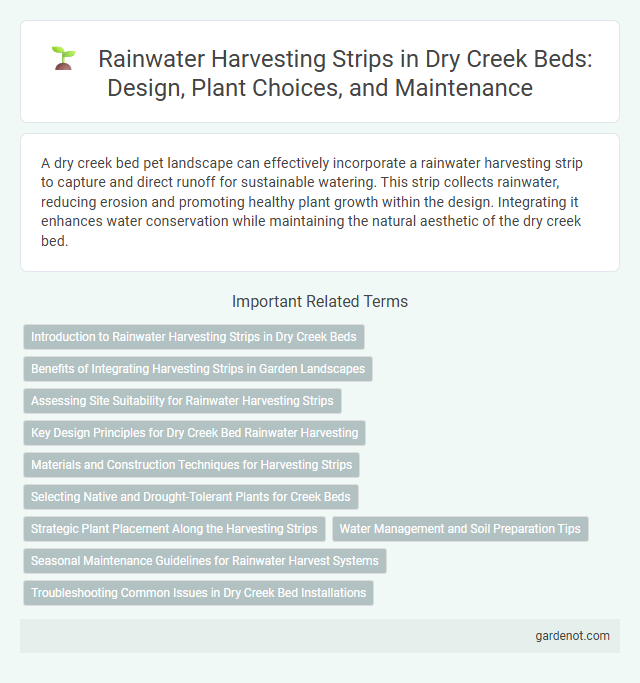A dry creek bed pet landscape can effectively incorporate a rainwater harvesting strip to capture and direct runoff for sustainable watering. This strip collects rainwater, reducing erosion and promoting healthy plant growth within the design. Integrating it enhances water conservation while maintaining the natural aesthetic of the dry creek bed.
Introduction to Rainwater Harvesting Strips in Dry Creek Beds
Rainwater harvesting strips in dry creek beds are engineered features designed to capture and store runoff during rainfall events. These strips slow down water flow, enhance infiltration, and reduce soil erosion in arid and semi-arid landscapes. Implementing rainwater harvesting strips improves groundwater recharge and promotes vegetation growth in otherwise dry creek systems.
Benefits of Integrating Harvesting Strips in Garden Landscapes
Rainwater harvesting strips in garden landscapes enhance water conservation by efficiently channeling runoff into soil, reducing erosion and promoting groundwater recharge. These strips support plant growth during dry periods by improving moisture retention and decreasing reliance on supplemental irrigation. Integrating harvesting strips also minimizes flood risk and contributes to sustainable urban drainage systems in residential and commercial green spaces.
Assessing Site Suitability for Rainwater Harvesting Strips
Evaluating soil permeability, slope gradient, and vegetation cover is crucial for determining the effectiveness of rainwater harvesting strips within a dry creek bed environment. Proper site assessment ensures optimal infiltration rates and reduces erosion risks, enhancing water retention and groundwater recharge. Incorporating local rainfall patterns and hydrological data further refines site suitability for sustainable rainwater management.
Key Design Principles for Dry Creek Bed Rainwater Harvesting
A rainwater harvesting strip in a dry creek bed utilizes natural topography to capture and infiltrate runoff, reducing erosion and promoting groundwater recharge. Key design principles include grading the creek bed to slow water flow, incorporating permeable materials for enhanced infiltration, and strategically placing vegetation to stabilize soil and filter pollutants. Optimizing strip width and gradient ensures effective water detention, maximizing the benefits of the dry creek bed as a sustainable stormwater management feature.
Materials and Construction Techniques for Harvesting Strips
Rainwater harvesting strips are typically constructed using permeable materials such as gravel, sand, and organic compost to enhance water infiltration and reduce runoff in dry creek beds. The construction involves layering these materials to create a filtration system that directs collected rainwater into the soil, promoting groundwater recharge. Techniques often include contour trenching and installing check dams to slow water flow, maximize absorption, and minimize erosion within the strip area.
Selecting Native and Drought-Tolerant Plants for Creek Beds
Selecting native and drought-tolerant plants for rainwater harvesting strips in dry creek beds enhances water retention and soil stability, reducing erosion and runoff. Species such as California sagebrush, purple coneflower, and desert marigold thrive in arid conditions, requiring minimal irrigation while supporting local biodiversity. Incorporating deep-rooted plants improves infiltration rates, promoting sustainable groundwater recharge in drought-prone landscapes.
Strategic Plant Placement Along the Harvesting Strips
Strategic plant placement along rainwater harvesting strips in dry creek beds maximizes water absorption and minimizes soil erosion by using deep-rooted native species that stabilize the soil. Integrating drought-tolerant vegetation such as native grasses and shrubs increases water retention, promotes groundwater recharge, and improves filtration of runoff. Positioning plants at varying elevations within the strip enhances water distribution and supports biodiversity in arid landscapes.
Water Management and Soil Preparation Tips
A rainwater harvesting strip within a dry creek bed enhances water management by efficiently capturing and directing runoff to replenish soil moisture and prevent erosion. Incorporating organic mulch and soil amendments like compost improves soil structure and water retention, promoting healthy plant growth. Strategic grading ensures even water distribution, while planting native drought-tolerant species stabilizes soil and maximizes water absorption.
Seasonal Maintenance Guidelines for Rainwater Harvest Systems
Maintain rainwater harvesting strips in dry creek beds by regularly clearing debris and sediment changes to ensure optimal water absorption and flow. Inspect and repair erosion control materials and vegetation to prevent soil displacement during seasonal rains. Monitor water retention capacity and adjust drainage paths to accommodate varying precipitation levels throughout the year.
Troubleshooting Common Issues in Dry Creek Bed Installations
Dry creek bed installations for rainwater harvesting often face issues such as improper grading, leading to water pooling or inadequate flow through the channel. Ensuring correct slope and compacted sub-base prevents erosion and helps maintain consistent water movement. Regular inspection and clearing of debris address blockages, preserving functionality and preventing overflow damage in the harvested rainwater strip.
Rainwater harvesting strip Infographic

 gardenot.com
gardenot.com